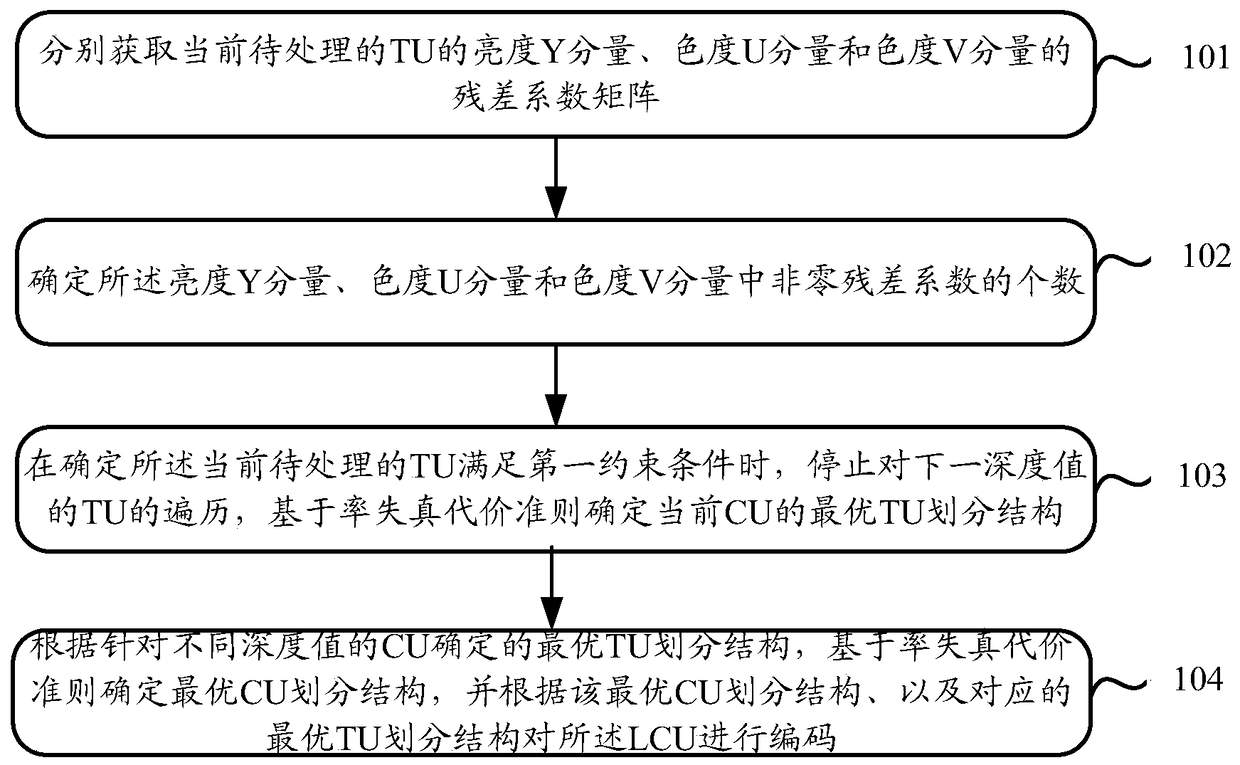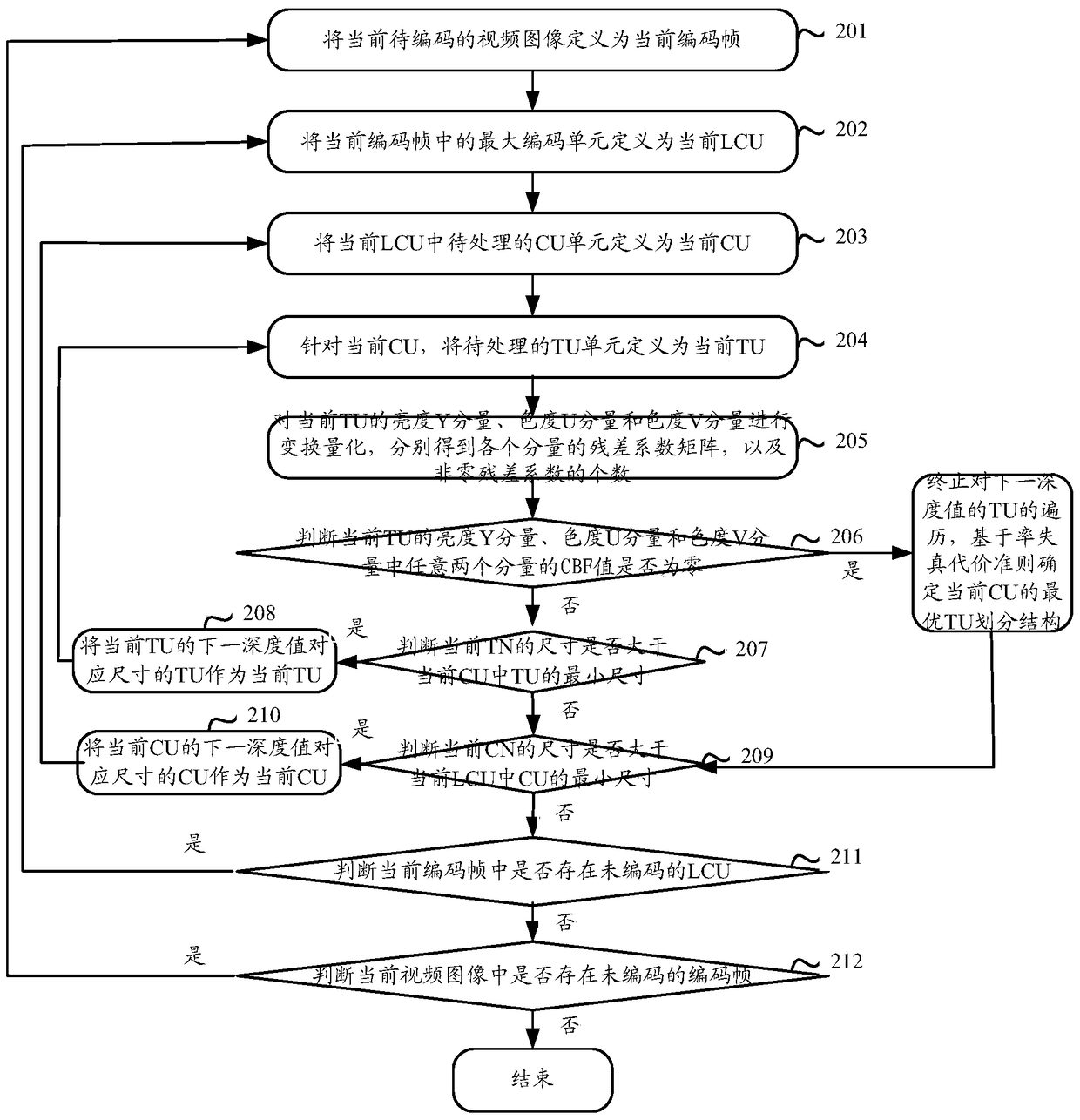A video coding method and device
A video encoding and component technology, which is applied in the field of image processing, can solve the problems of high encoding complexity and long time required for video encoding, and achieve the effects of reducing the number of recursive traversals, saving time, and reducing complexity
- Summary
- Abstract
- Description
- Claims
- Application Information
AI Technical Summary
Problems solved by technology
Method used
Image
Examples
Embodiment 1
[0037] like figure 2 As shown, it is a schematic flowchart of a video encoding method provided by Embodiment 1 of the present invention, which mainly includes the following steps:
[0038]Step 101: Obtain the residual coefficient matrices of the luma Y component, chrominance U component and chrominance V component of the current TU to be processed for the coding units CU with different depth values in the current largest coding unit LCU determined in the video frame.
[0039] Sub-step 102: Determine the number of non-zero residual coefficients in the luma Y component, chrominance U component and chrominance V component.
[0040] Sub-step 103: When it is determined that the TU currently to be processed satisfies the first constraint condition, stop traversing the TU of the next depth value, and determine the optimal TU partition structure of the current CU based on the rate-distortion cost criterion; wherein, the The first constraint condition is: the CBF value of any two c...
example 1
[0059] like image 3 As shown, it is a schematic flow chart of a video coding method provided by Example 1 of the present invention, which specifically includes:
[0060] Step 201: Define the current video image to be encoded as the current encoding frame.
[0061] Since video encoding is performed on each frame of image, and the processing method of each frame of image is similar, only the currently selected video image to be encoded is processed.
[0062] Step 202: Define the largest coding unit in the current coding frame as the current LCU, and define the size range of the CU in the current LCU as: {MaxCUsize, MinCUsize}, and the depth value of the CU is CI.
[0063] Assuming that the size of the current LCU is 64×64, then the size range of the CU in the current LCU is: {64×64, 8×8}, and the range of the depth value of the CU is: {0, 3}.
[0064] Step 203: Define the CU unit to be processed in the current LCU as the current CU, and define the size of the current CU as CN...
example 2
[0081] like Figure 4 As shown, it is a schematic flow chart of a video encoding method provided by Example 2 of the present invention, which specifically includes:
[0082] Step 301: Define the current video image to be encoded as the current encoding frame.
[0083] Step 302: Define the largest coding unit in the current coding frame as the current LCU, and define the size range of the CU in the current LCU as: {MaxCUsize, MinCUsize}, and the depth value of the CU is CI.
[0084] Step 303: Define the CU unit to be processed in the current LCU as the current CU, and define the size of the current CU as CN.
[0085] Step 304: For the current CU, define the TU unit to be processed as the current TU, and define the size of the current TU as TN.
[0086] Step 305: Transform and quantize the luma Y component, chrominance U component, and chrominance V component of the current TU to obtain the residual coefficient matrix of each component and the number of non-zero residual coeff...
PUM
 Login to View More
Login to View More Abstract
Description
Claims
Application Information
 Login to View More
Login to View More - R&D
- Intellectual Property
- Life Sciences
- Materials
- Tech Scout
- Unparalleled Data Quality
- Higher Quality Content
- 60% Fewer Hallucinations
Browse by: Latest US Patents, China's latest patents, Technical Efficacy Thesaurus, Application Domain, Technology Topic, Popular Technical Reports.
© 2025 PatSnap. All rights reserved.Legal|Privacy policy|Modern Slavery Act Transparency Statement|Sitemap|About US| Contact US: help@patsnap.com



